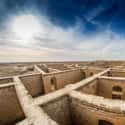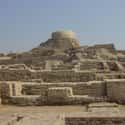-
(#4) Sumer
Sumer is considered the "cradle of civilization" due to it being one of the earliest cultures to appear on the historical scene. It is unclear when the first Sumerians migrated between the Euphrates and Tigris rivers, but by 3600 BCE, they'd created the world's first cities, including Ur, Eridu, and Uruk.
The development from primarily small settlements to cities was a slow, thousand-year-long process, and the Sumerians depicted this transformation in a cuneiform document from 2100 BCE called the "Sumerian King List." It is described as a period in which the gods and Sumer's kings were able to triumph over chaos. During this time, the society created systems and inventions to harness or counteract the harsh conditions of what is now modern Iraq, including irrigation, the wheel, and sailboats.
Despite adapting technology to allow society to grow larger than ever before, Sumer's greatest achievements occurred around 2000-1750 BCE, in a period that was later named the Sumerian Renaissance. During this period, the Sumerians created basic standards that are taken for granted today, including the concept of time.
The Sumerians had a duodecimal and sexagesimal counting system (meaning they had a 12-based and 60-based counting system, rather than the decimal 10-based system used today) and divided the days by the same system.
The Sumerians also created the world's first legal code, named after the Babylonian king who created it, Hammurabi. Hammurabi's Code provided the basis for city and legal administration by defining rules that every citizen must abide by.
-
(#10) Indus Valley Civilization
Along the Indus River in modern-day Pakistan, Afghanistan, and Northwestern India, arose one of the earliest human civilizations, the Indus Valley Civilization. Also known as the Harappan, the Indus Valley people flourished in the region for about 2,000 years between 3300 BCE and 1300 BCE and established 500 discovered settlements throughout the entire region.
Despite being such an important civilization to the history of human development, much of it remains a mystery. Archaeological evidence suggests the civilization was incredibly complex: they invented irrigation and drainage systems, a standardized weight and measurement system (useful for trade), sprawling urban centers, and a written language that has yet to be deciphered.
Modern historians and archaeologists have no idea how the society functioned or what happened to it. There are very few written records, no statues or monuments of kings or conquerors, and no depictions of any war or battles.
The most well-known settlement of the Indus Valley Civilization is the city of Mohenjo-Daro. The city itself was larger and more advanced than most other cities of the time; it was built using clay brick on a well-coordinated grid, housed 40,000 people, and below it was a sophisticated drainage and water management system that allowed every home its own bath. Despite public baths with underground furnace systems, assembly halls, marketplaces, and ancient apartment buildings, there is no building that indicates a seat of power or central governance.
The people and their cities remain a mystery, as does the reason for the civilization's collapse. Around 1700 BCE, the civilization seemingly disappeared without any trace. Historians have theorized the civilization dispersed from sprawling urban centers after a major shift in staple crops from wheat and barley to rice and millet. Yet the reason for the decline is still heavily debated.
-
(#3) The Rapanui
Some 2,300 miles off the coast of Chile is a small island called Rapa Nui, also referred to as Easter Island, originally settled by migrating Polynesians between 300 and 400 CE. They developed a rich culture, evident by the 900 or so enormous stone figures scattered around the 63-square-mile island.
Often mounted atop stone platforms called ahus, these stone statues, or moai, were chiseled from tuff, a porous volcanic rock. Though they were obviously used for a ceremonial purpose, historians and archaeologists have no idea what specific role they played, why the Rapanui made such a large quantity, or how they managed to move them. Each moai is about 32 feet tall and weighs about 82 tons.
Historians suggest the Rapanui cut down palm trees and used those logs to transport the stone heads. Regardless of whether or not that was the method, making and transporting the moai would have taken great amounts of manpower.
Based on how barren the island is now and the erosion that has taken place, it's theorized that the Rapanui left a huge ecological effect on the island, which may have caused the entire civilization to collapse. By wiping out most of the island's palm trees and replacing them with agricultural land, most of the nutrient-rich soil eroded. Without that soil, the crops dwindled, and in the ensuing years the island's population struggled through intermittent periods of conflict and peace.
-
(#12) Ancient Rome
Though Rome began as a small city-state on the Tiber River around 750 BCE, it grew into an empire that spanned first the entire Mediterranean and then large parts of Western Europe as well. Ancient Rome was incredibly adaptable to foreign ideas and was often willing to improve upon them - maybe not in the aspect of intellectual theory, but in practice.
There is a common proverb that "all roads lead to Rome." Though it's meant to be a figurative way of explaining there are multiple ways to get to a certain conclusion, there is also a very literal truth to it, and serves as a testament to the empire's civil engineering: all roads did, in fact, lead to Rome.
Beginning very early in their history, the Romans began building roads that connected major cities, similar to a modern highway system. The road connecting Capua to Rome, called the Via Appia, covered 121 miles and took the straightest possible path. The Romans built gravel and cement roads through the entire empire and disregarded any changes in the terrain by creating extensive bridges and tunnels. They created efficiency within their empire that far exceeded any other civilization at the time - or that would succeed it for many centuries.
Their engineering accomplishments, however, did not end with general civil engineering projects. There were plenty of grand monuments around the empire, including the Hippodrome of Constantinople, the Pantheon, and probably most famous of all, the Roman Colosseum.
The Colosseum was a four-story stadium that could seat about 50,000 people. It was built from a uniquely Roman material called Roman concrete, which historians have noted is even more durable than modern cement. Through a complex gear system, the Romans designed a floor that could retract into the ground, allowing them to adjust the stadium's interiors to the specific needs of that day's event. In addition to gladiatorial games and wild animal hunts, the arena could also be modified to stage "naumachiae," or mock naval battles.
-
(#8) The Kingdom Of Zimbabwe
On the southern end of modern Zimbabwe are the ruins of Great Zimbabwe, a 1,779-acre fortress city that towers above the Limpopo and Zambezi Rivers. Built around the 10th century by the Shona, a Bantu-speaking people native to South Africa, this city housed an estimated 18,000 people in what may have been the capital of a much larger empire.
The cities surrounding the mountains contain more than 4,000 gold mines and 500 copper mines, which some historians estimate produced 40% of the world's gold during the empire's height (between the 11th and 14th century CE). Evident from many non-African goods found within the city, Great Zimbabwe was a center of trade connecting the Middle East and South Asia to Central and Southern Africa through the Mozambique coast.
Only 2% of the entire city has been excavated, but its walls are already considered a marvel of ancient engineering. The 36-foot-tall wall surrounds the entire city, but there is no mortar keeping the stones in place. Despite having no binders, the majority of the wall, as well as the towers and turrets around the city, has stayed intact for more than eight centuries.
This building technique was not limited to the city's defenses. In the city center is a tower measuring 32 feet high and 820 feet in circumference, and made of 900,000 pieces of granite, each sliced with professional precision. These, too, are stacked without any form of binder to keep them in place. The tower is surrounded by soapstone sculptures depicting bird-like creatures that have human lips and feet.
Europeans who encountered Great Zimbabwe in the 19th century could not believe the Shona or any other Bantu people - who had abandoned the city in the 15th century and dispersed into smaller settlements - could have built this engineering wonder. They instead theorized foreigners – Persian, Portuguese, Chinese, or Arab – traveled to Zimbabwe to create this city, but that was proven false by a British archaeologist in 1905.
-
(#1) Ancient Egypt
Mystery and intrigue have surrounded the ruins of Ancient Egypt for several millennia. Around 3,000 BCE, people began to congregate along the lower Nile River and soon created one of the greatest civilizations in human history. Their cultural output, their riches, and their engineering astounded the ancient world.
The Egyptians boasted a complex hieroglyph writing system, developed a sophisticated mummification process, and created incredible monumental structures that have survived to this day.
Some of Ancient Egypt's most well-known structures are the Pyramids of Giza - the largest of which, the Pyramid of Khufu, is the only remnant of the Seven Wonders of the Ancient World. It has a base of 756 feet, and when originally built, reached 481 feet in height. It was the tallest human-made structure for more than 3,000 years of recorded history.
The immense Pyramid of Khufu is even more incredible when considering it was made by the precise placement of stones that could weigh more than 60 tons. Historians don't completely agree on how the Egyptians made the pyramids, or the size of the workforce required to build them, but there are many theories. Since the Egyptians did not have crane technology, some historians theorize the Egyptians used ramps. Others, however, claim this would be impractical; the stones would be too large, the ramps too long, and the workforce too small to do this in a timely manner.
Instead of ramps, others believe the Egyptians developed a complex hydraulic system, as suggested by the intricate shafts in the pyramid's interior and the high water table inside the Pyramid of Khufu.
Regardless of how the pyramids were made, the Ancient Egyptians were a highly advanced society and became the jewel of the ancient world, so much so that they became a target of envy and military domination.
New Random Displays Display All By Ranking
About This Tool
There are many ancient cultural sites on the earth that have always been the focus of research by scientists and archaeologists because these ancient buildings are the witnesses of human civilization, but some great civilizations have appeared buildings that are too big, too heavy, or too complex, they suspected of being built by aliens. Do you believe in the existence of aliens?
Some people think that the ancient builders of the Egyptian pyramids and the Nazca Line followed the instructions of the aliens. Perhaps the people who built these great buildings did not belong to the earth. The random tool lists 12 ancient civilizations that may be contacted by aliens.
Our data comes from Ranker, If you want to participate in the ranking of items displayed on this page, please click here.
















